Note: This article includes certain images that are, by 21st century standards, objectionable. They were, or should have been, similarly repugnant 150 years ago. But they are important examples of what minorities, including Williston’s first group of Chinese students, had to endure at the time. Recent national controversies have served to remind us that if we do not confront and acknowledge our mistakes, then progress is impossible.
The Earliest International Students
Williston Seminary, founded in 1841, had an international student clientele from the very beginning of its history. Among the first students to enroll were brothers Warren and J. Evarts Chamberlain, from the Sandwich Islands, now Hawai’i. They, like many students from abroad, were the children of Christian missionaries, sent home for the very practical reason that there were no secondary schools available where their parents were stationed. In the first two decades missionary children also arrived from Turkey and Syria. In the 1860s we start to see scholars from Persia and from South Asia: India, Ceylon. But East Asia is not represented at all. And indeed, one might argue whether an American living abroad, even if born there, might truly be called an “international student.” Meanwhile, the great majority of students hailed from the Northeast.
The very first “real” international student, one Sumner Bridgman, arrived in the fall of 1844, from Saint-Pie, Quebec, Canada. Not especially exotic, to be sure, but in any event, he didn’t stay long. He was followed in 1845 by compatriot Mary Pomeroy of Compton, Quebec, who had the distinction of being not only Williston Seminary’s first female international student, but also the last. (See “A Perfect Paradise on Earth.”) The first European students were William Marcussohn, of Odessa, Russia, who arrived in the fall of 1847, and Francisco Leiro, from Corunna, Spain, in 1848. The names and origins of all Williston students are exhaustively recorded in the Annual Catalogue of Williston Seminary. Unfortunately, prior to 1873, individual student transcripts (if they ever existed) do not survive, so we rarely have much contemporary detail on the lives of many students at the time of their enrollment.
The population of “true” international students started to grow in 1869-70. In the next four years the school would welcome multiple students from Denmark, Turkey, and notably, Japan. Then, beginning in academic 1875-76 and culminating in 1880-81, eleven young men from China would enroll. They attended under the auspices of a remarkable program, the Chinese Educational Mission (CEM).
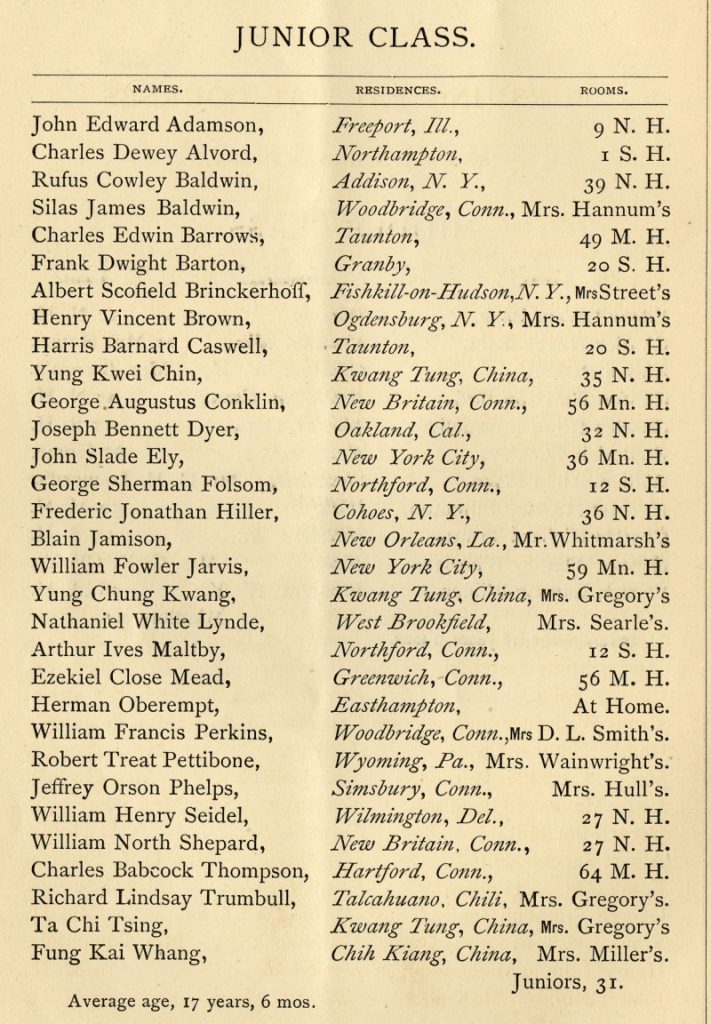
A Note on Sources
The history of the Chinese Educational Mission has been treated in two excellent volumes, China’s First Hundred: Educational Mission Students in the United States, 1872-1881, by Thomas E. LaFargue (1942), and Edward J. M. Rhoads’ Stepping Forth Into the World: The Chinese Educational Mission to the United States, 1872-81 (2011). Professor Rhoads made extensive use of the Williston Northampton Archives in researching the latter. Full citations for both volumes are at the end of this post. Both books are highly recommended
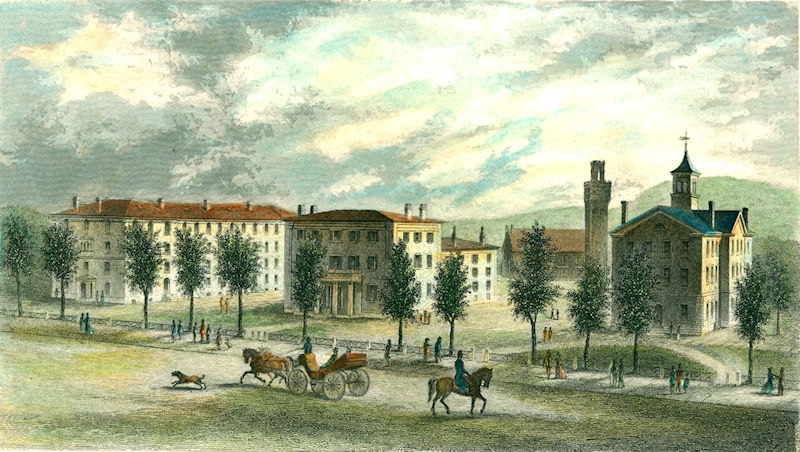
China and the West
19th century China was largely, and by design, a society isolated from the rest of the world. Modernization – of the government, the military establishment, the educational system – came slowly. Efforts were made to limit exposure to unwelcome ideas that contradicted or distracted from centuries-old Confucian principles. Until mid-century, China had only one major international port of entry, the southern city of Guangdong (Canton). The British had used it to gain access to and influence in the interior. In a particularly cynical effort to gain leverage, Britain, whose East India Company held a monopoly on Indian-grown opium, had encouraged the use of the drug in China to create a demand for it. Opium could then be traded for Chinese silks, porcelains, and other goods much in demand in the West. This had been going on since the 1780s, but it eventually led to the First Opium War of 1839-1842. Hopelessly outgunned, China was forced to make significant concessions to Britain. A second conflict, 1856-1860, which also involved France, was even more disastrous for China. Opium was virtually legalized, ten treaty ports were established along the coast, and China was forced to move her capital to Nanjing after the British occupied Beijing (Sizer, 33-40, 48). But finally, even in the most conservative government circles, it was becoming apparent that access to Western technology, both military and industrial, was essential. This eventually led to the establishment of the Chinese Educational Mission.
The evangelical spirit of the times served only to exacerbate the situation. With European traders and soldiers came a wave of missionaries. True, there had been a handful of Christian proselytes in China since the thirteen century, but their impact was slight. This time it was different; it seemed that “the conviction of Europeans that it was their Christian duty and the manifest destiny of the people of the Occident to bring to China the fruits of western civilization was accepted without question” (LaFargue 1). As shall be seen, this dynamic would effect the CEM students in both the restrictions placed upon them by their Chinese sponsors, and the expectations made of them by their American hosts.
The Chinese Educational Mission
Yung Wing (1828-1912) shepherded the Chinese Educational Mission into being. Initially taught in a Christian mission school in Guangdong, he had accompanied one of his teachers to the United States and completed his education there, eventually graduating from Yale in 1854. He may well be the first Chinese national to obtain an American education (LaFargue, 18). While at Yale he had become convinced of the need for China to explore Western educational and technological models as alternatives to the traditional systems. Although he had taken American citizenship, he returned to China in 1854, and became a tea merchant and translator. Eventually he found himself in a position to lobby officials in the Imperial court about his idea for educating Chinese boys abroad (LaFargue 17-31). He became associated with a powerful official, Zeng Guofan (Tsêng Kuo-Fan). In 1864-65, on Zeng’s behalf, Yung went back to the United States to purchase machinery for a modern arsenal and shipyard. Zeng, who shared Yung’s passion for military, industrial, and educational reform, had substantial leverage in the Imperial court (LaFargue 24-28). Thus, in 1870, the Chinese Educational Mission was approved. Yung Wing was named one of the Governors.
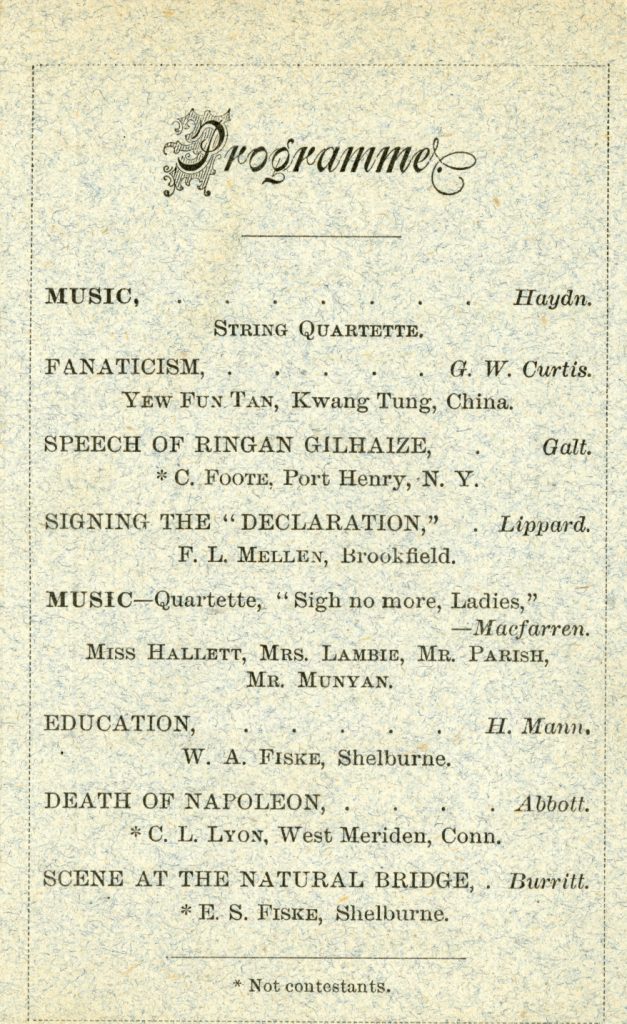
The first task was to recruit a group of students whose parents were willing to permit them to travel abroad for several years. Ultimately, and despite a variety of challenges detailed by Rhoads and LaFargue (Rhoads 13-30; LaFargue 33-34), 120 boys, most in early adolescence and a majority from rural areas neighboring Guangdong in the South and Hangzhou in the East, were selected. Few came from the North, those only toward the end of the program. None came from the ruling Manchu families (LaFargue 34). The boys were gathered at a school in Shanghai for initial orientation and English study.
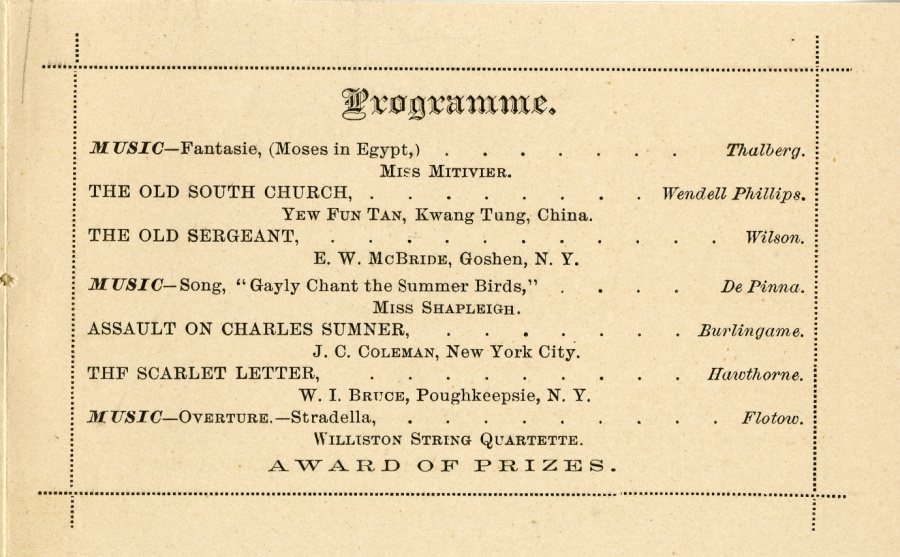
Management of the program in the United States would be by a Chinese Educational Commission (CEC), headquartered in Yung Wing’s old student hometown of Hartford, Connecticut. Yung and a Chinese scholar, Chun Lanbin, were named Commissioners. In 1871 they traveled to Hartford to make arrangements for the boys’ arrival. The students, most aged 12-14 (Rhoads 18), would come in four groups, 1872-1875. They were placed with host families in central Connecticut and Massachusetts, and divided their study time between local schools and the CEC. Following two or three years of preparatory education, each student would enroll in a public or private secondary school in the Connecticut Valley. From 1875 to 1881, eleven students from the first two groups would attend Williston Seminary. They were:
Chen Ronggui (Yung Kwei Chin), class of 1879s*, attended 1876-79
Cheng Daqi (Ta Chi Tsing), class of 1879c, attended 1876-77
Liu Jiazhao (Kia Chau Low), class of 1880c, attended 1876-80
Tan Yaoxun (Yew Fun Tan), class of 1879c, attended 1876-79
Fang Boliang (Pah Liang Fong), class of 1880c/1880s, attended 1876-80
Kuang Yonzhong (Yung Chung Kwang), class of 1879s, attended 1876-79
Wang Fengjie (Fung Kai Whang), class of 1879s, attended 1876-79
Zhang Xianghe (Cheong Cheung Woo), class of 1880s/1881c, attended 1877-79
Kuang Jingyang (King Yang Kwong), class of 1880s/1881s, attended 1877-80
Kuang Xianzhou (Ying Chow Kwong), class of 1880s/1881s, attended 1877-80
Yang Zhaonan (Siu Nam Yang), class of 1880s, attended 1877-79
(*The designations “s” and “c” following the class year denote Williston Seminary’s two curricular divisions, Scientific and Classical. Fang Boliang and Zhang Xianghe switched divisions during their times at Williston. Zhang Xianghe and the Kuang brothers appear to have transferred to later classes.)

A Note on Names
For this article we have followed Professor Rhoads’ lead and rendered all Chinese names using the modern Pinyin system of Chinese transliteration, developed in the 1950s. It differed from the older and less consistent Wade-Giles system, used by Thomas LaFargue. In the 19th century there was no translation standard at all. In the list above, the names in parentheses are those that appear in the Annual Catalogue of Williston Seminary’s rosters. Chinese and Pinyin practice places the surmame first; Williston followed English convention and placed it last – most of the time. To add to the confusion, not only are LaFargue’s name renderings often different, but students’ names are spectacularly inconsistent from one catalogue to the next. Kuang Jingyang and Kuang Xianzhou appear as Kwang and Kwong in alternate years. Tan Yaoxun is rendered Yan Fun Tan and Yew Fun Tan in different volumes. Liu Jiazhou is listed three ways – Kia Chau Lew, Kia Chan Low, and Kia Chau Low, while Zhang Xianghe’s name seems miles away from Williston’s “Cheong Cheung Woo.” Happily, Rhoads has provided a table of accurate pairings (51-54).
Expectations
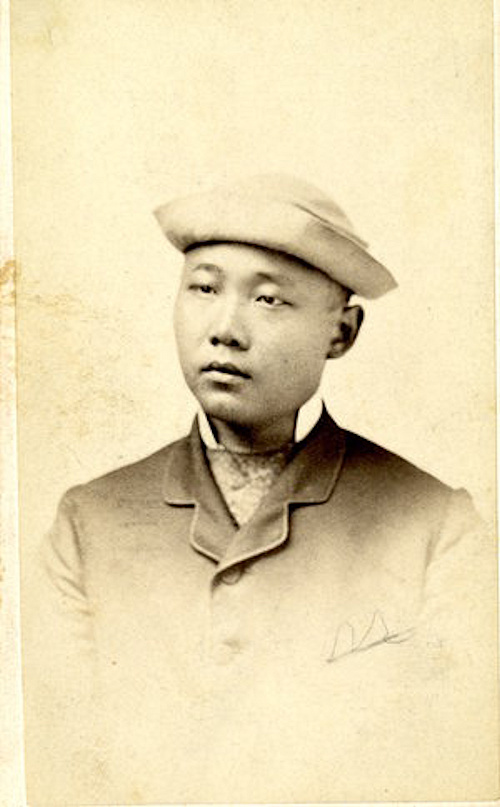
CEM had very clear expectations for its young gentlemen. Once accepted into the program, they were considered to have passed the first level of civil service examinations, and were now government employees, even granted a stipend to cover clothing and travel expenses. They were to obtain American secondary educations and continue at American colleges, then return to China to share what they had learned. They were expected never to abandon their national cultural identites. This included not cutting their queues and appearing only in traditional robes (Rhoads 29-30, 148-150). The last injunction proved impractical. Not only did the boys often draw undue attention and ridicule upon themselves, but growing adolescents need new clothes. The dress code was modified so that students were required to wear Chinese clothing only when returning to CEM headquarters, or at official functions (Rhoads 149).
The Host Family Experience
Most of the students were assigned to live with private families in the greater Hartford-Springfield-Northampton orbit. One criterion appears to have been easy accesibility to Hartford by train (Rhoads 50), since the boys were expected to return to Hartford frequently for group activity and lessons in Chinese language and culture. Of the eleven who would eventually attend Williston, it is not known where Chen Ronggui and Cheng Daqi stayed. Liu Jiazhao and Tan Yaoxun lived with a Miss Martha Burt in Oakham, Mass., closer to Worcester than Springfield, thus a considerable distance away. Wang Fengjie and Zhang Xianghe went to Miss Clara Alford in Farms Village, Conn., now part of the Hartford suburb of Simsbury; Kuang Jingyang and Kuang Xianzhou, to Miss Dorcas Miller, the librarian in Easthampton. Fang Boliang and Kuang Yonzhong lived with an unidentified host in Wilbraham, Mass., near Springfield. Yang Zhaonan was with Rev. & Mrs. John Lane in Whately, near Northampton, along with another student who would eventually attend Hartford High School (Rhoads 51-54).
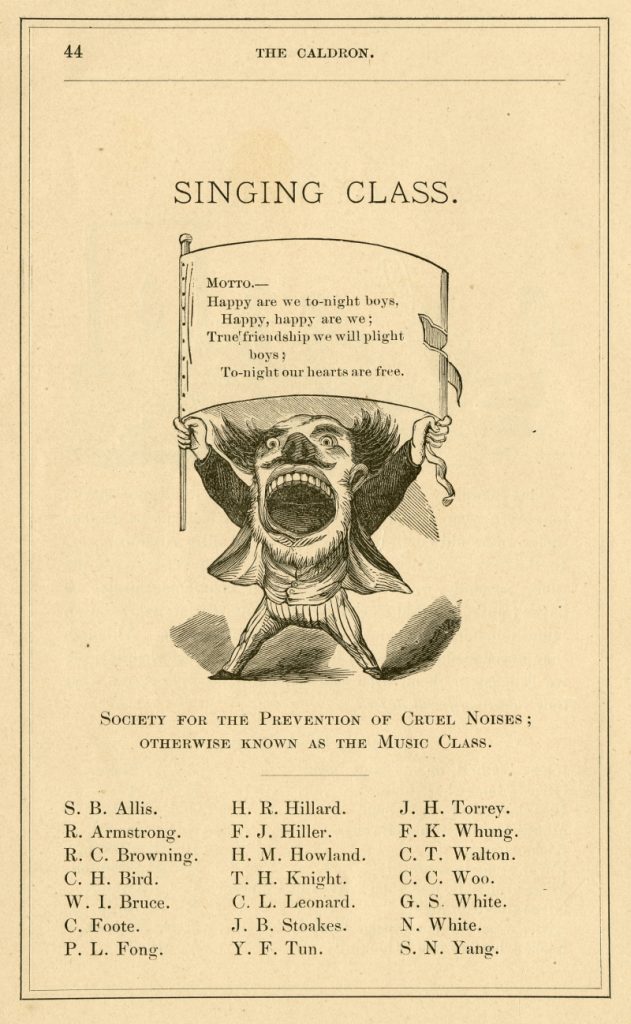
There appears to have been an effort to ensure that most students had companions. It seems significant that of the nine future Williston students whose early placement we know, eight stayed together when they entered high school. Williston may have been an obvious choice for the boys in Easthampton and Whately; less so for those in Wilbraham and Oakham. It is surprising that so many students boarded with unmarried women, but Rhoads, who has provided a thorough analysis of the host families’ demographics – educated, often professional, and entirely Protestant (59-63) – notes that in every instance, the unmarried hosts resided with their parents, who took part in the boys’ home schooling (Rhoads 60). For boys half a world from home, in what must at times have seemed a baffling culture, the nurturing aspects of family life may well have been more important than their English lessons. Indeed, many of the students developed strong ties with their hosts, some of which endured long after the students had returned to China (Rhoads 74).
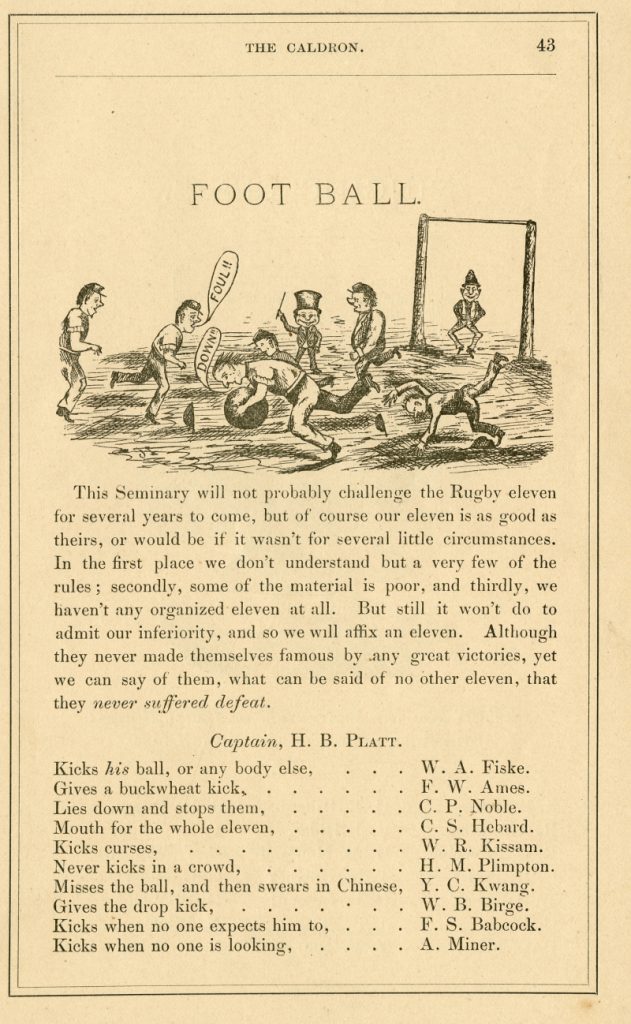
It is also no surprise that many CEM students, expected to participate in the lives of their host families and communities, became interested in Christianity (Rhoads 66, 152-157). Every one of the host families was Protestant, mostly Congregational, at a time of great evangelical ferment in New England. Many host households were headed by clergy. In all likelihood, most boys attended Sunday services with their hosts, and took part in daily home prayers. It was inevitable that some would convert.
The Chinese Christian Home Mission
That was the case at Williston Seminary, where the first seven of eleven Chinese enrolled in the fall of 1876. Although nonsectarian in its admission policies, Williston was Congregational in practice. Faculty member and future Headmaster Joseph Sawyer writes, “No effort had been made to interest [the Chinese] boys in the Christian religion. They were required, as all pupils were required, to attend daily morning prayers and church services on Sunday. This was accepted as a school regulation” (Sawyer, History, 233). This seems a shade disingenuous on Sawyer’s part. In any case, by Sawyer’s account, in the winter of 1877-78 five Chinese students approached the Rev. A. R. Merriam, of the Payson Church, desiring to publicly declare their Christian faith. Someone – Sawyer? Principal James Whiton? – wisely consulted Yung Wing, who advised that “liberty to study the history and doctrines of the Christian religion was granted, and right of private opinion was accorded, but so long as they were wards of the Chinese government nothing overt must occur.” So the boys privately founded a group called the Chinese Christian Home Mission, prepared a constitution and statement of faith, and declared that their goal was to convert China to Christianity. Eight of Williston’s Chinese ultimately joined. If, as Sawyer states, “membership never exceeded thirteen” then a few students from other institutions must also have signed on (Sawyer, History, 234-235).
Despite the small numbers, the rise of the Chinese Christian Home Mission would prove significant. It would inform student Tan Yaoxun’s actions when the CEM program was shut down in 1881. And if Sawyer’s account in the journal The Independent is not exaggerated, it became part of the Chinese government’s reasoning for the suspension of the program (Sawyer, Chinese, [7-8]).
Academic Life at Williston Seminary
The CEM students’ academic transcripts are entered in a huge, leather-bound folio now too fragile and faded to successfully reproduce here. But they are mostly readable. From them, we may discover that all were enrolled in ambitious programs, mostly, but not exclusively in the Scientific division. Their grades tended to be respectable or better; there is only one instance of someone failing a course (algebra) and needing to repeat it. But a fair number of students had early difficulty in mathematics, possibly because they needed to acquire an English-language technical vocabulary that matched their mathematical skills. (This remains a challenge for some international students today.) Many also struggled in elocution – perhaps not a surprise, when one considers that most had been studying English for only a couple of years when they enrolled. The transcripts include grades in “Deportment.” Only Liu Jiazhao ever received a deportment score of less than 95; some bad act earned him an egregious 80 in 1878. Everyone else scored consistent 95s and 100s, at a time when many traditional students regularly received failing grades. Clearly, the Chinese students made a point of staying out of trouble.
But of the eleven, only four, Kuang Yonzhong, Liu Jiazhao, Tan Yaoxun, and Wang Fengjie, graduated. The transcripts of four others, Chen Ronggui, Fang Boliang, Kuang Jingyang, and Kuang Xianzhou, indicate that they had “completed [the] course.” Were they in some kind of non-diploma program? It appears to have had little effect on further educational plans; Chen Ronggui qualified for Sheffield Scientific School at Yale, and attended Lehigh; while Fang Boliang, Kuang Jingyang, and Kuang Xianzhou all enrolled at Massachusetts Iinstitute of Technology. Among the graduates, Liu Jiazhao and Tan Yaoxun entered Yale, Kuang Yonzhong, MIT, and Wang Fengjie, Lehigh.
Despite issues with elocution, in 1879 two Chinese students were honored with the opportunity to address the school, in the presence of parents and visiting dignitaries, in an oratory competition and the Senior’s Day exercises associated with graduation. In the declamation contest, Tan Yaoxun, who had participated in oratory competitions as early as 1877 [see Fig. 4], read “The Old South Church,” by Wendell Phillips, and was awarded first prize [Fig. 5]. At Senior’s Day, Wang Fengjie delivered his own essay on “Confucius.” [Fig. 13] The following year, Liu Jiazhao addressed Senior’s Day on “The Future of China.” [Fig. 14]
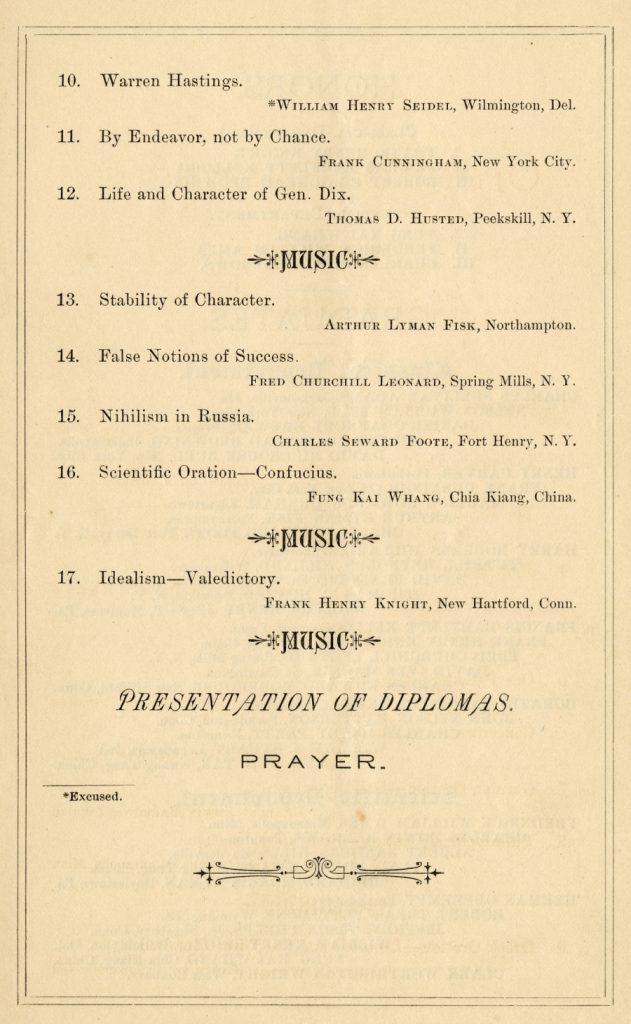
Three did not stay: Cheng Daqi withdrew in 1877 because of illness, and was sent home (Rhoads, 136). Yang Zhaonan’s transcript indicates that he left in 1879 because he “wanted a change”; he enrolled at Phillips Andover and went on to MIT (Rhoads, 116). No reason is given for Zhang Xianghe’s 1879 withdrawal. He finished at Hartford High School and matriculated at Rensselaer (Rhoads, 117).
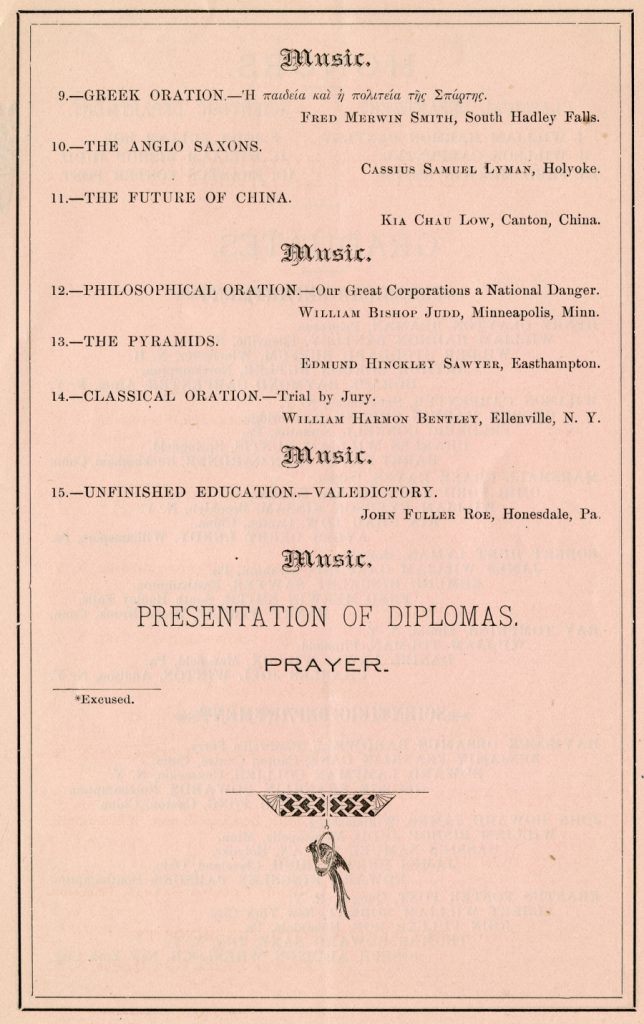
Social Life
There is not a lot of documentation concerning the students’ lives outside of class. How well were they integrated into the school mainstream? Also present were students from Japan, Turkey, Chile, and Denmark, but the Chinese represented the largest national group. The Annual Catalogue and The Caldron indicate that the Chinese roomed in pairs and dined together in a local boarding house. (The Caldron was an early attempt at a school yearbook. It was often satirical, frequently tasteless, and sometimes scurrilous in content. Four annual issues were prepared, beginning in 1877, one of which (1879) was confiscated at the printer and never distributed.) Perhaps the Chinese boys mostly kept to themselves outside of class. There is a student autograph album [Fig. 6], kept in 1873-78 by one Samuel Baxter Allis, that contains Chinese signatures and inscriptions, some of which appear to date from the students’ time at Wesleyan Academy in Wilbraham, prior to enrolling at Williston. There is little else to suggest widespread social relations.
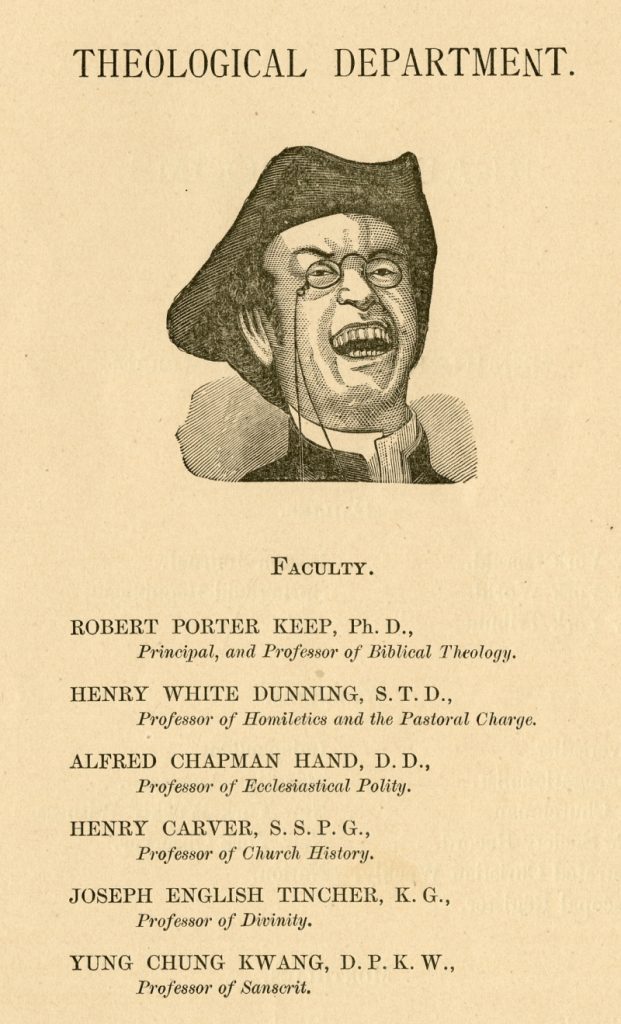
In fact, in The Caldron’s pages devoted to the school’s many clubs and societies, Chinese and other non-English names are conspicuously absent. The great exception is the “Singing Class,” the equivalent of the school’s large choir, in which several Chinese participated. [Fig. 8] No Chinese names appear in the rosters of Williston’s two debating and literary societies, nor of any athletic organization, with one exception. In 1878, Kuang Yonzhong turns up on a page devoted to football, albeit one suggesting that the game, in its earliest days at Williston, barely deserved mention at all [Fig. 9]. The overall lack of Chinese participation is very different from the experiences at other schools, where many Chinese excelled in sports (Rhoads, 144-147).
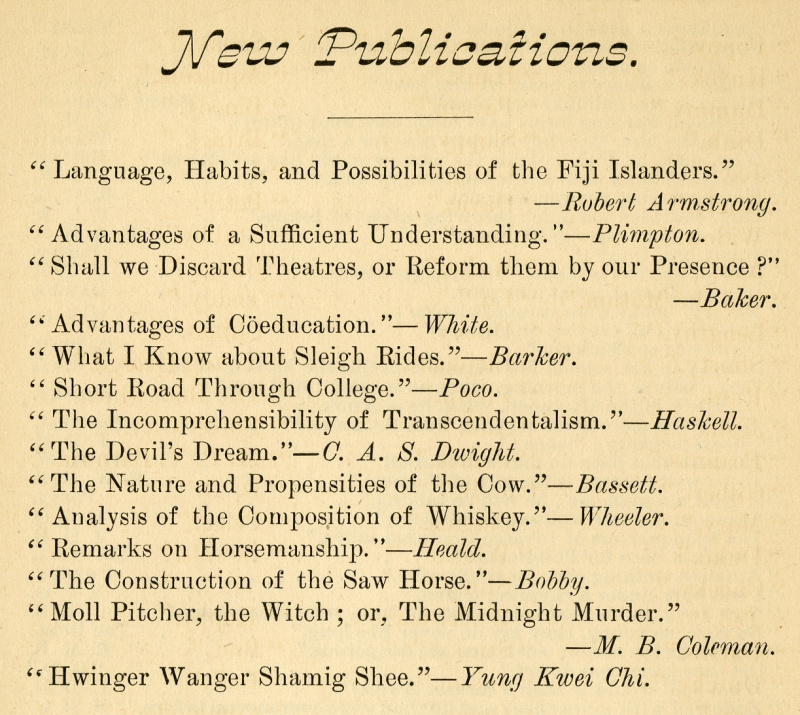
Some of The Caldron’s satirical attempts seem intentionally offensive. The roster of a fictional “Theological Department” includes the names of several students, including Kuang Yonzhong as “Professor of Sanskrit.” [Fig. 15] Innocuous enough. But a list of “New Publications” – mostly “in” jokes about the proclivities of several students – ascribes a torrent of pseudo-Chinese gibberish to Chen Ronggui. [Fig. 16] Two 1877 pages devoted to the school’s international and ethnic population cite “Heathen Chinee.” [Fig. 17] The expression derives from a widely circulated 1870 satirical poem by Bret Harte, although most authorities on Harte note that by and large the public didn’t recognize it as satire (Metraux). And the phrase appears again in the same issue, in a section devoted to student eating clubs, where a list of the regulars at the boarding house where several Chinese took there meals is accompanied by a crude caricature we will not dignify by reproducing here.
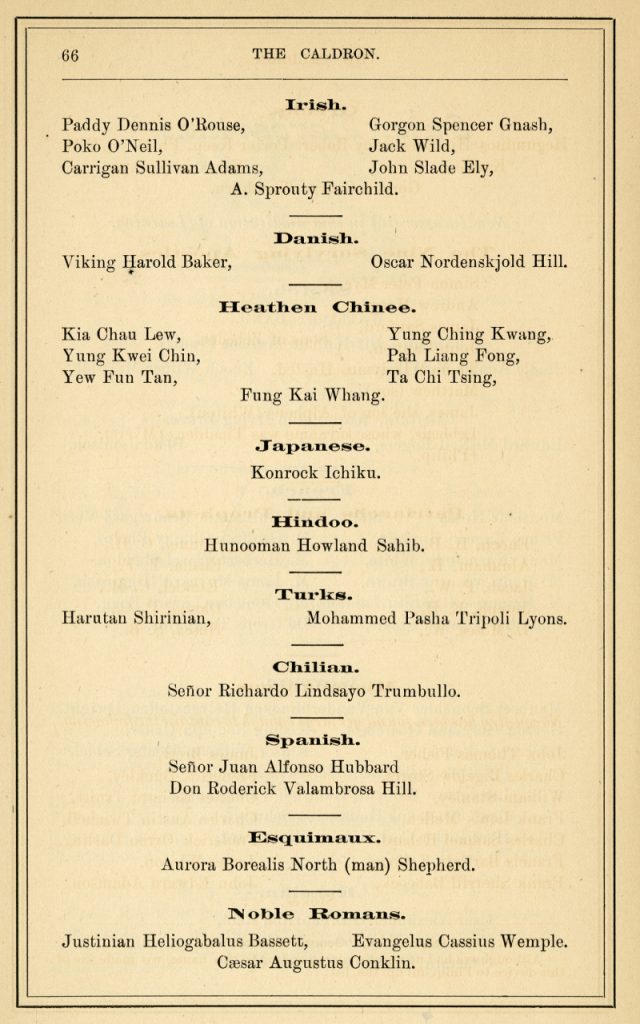
The Whiton Affair
There was an additional distraction that must have impacted the CEM students. Williston Principal Marshall Henshaw had stepped down in 1876. His successor, the Rev. James Morris Whiton, was deservedly unpopular: arbitrary in his decisions, short-tempered, with a tendency to overreact to student hijinks. Inevitably, teenagers being teenagers, some students began to devote considerable energy to undermining him. Things escalated until a silly practical joke ended in open rebellion. In April, 1878, someone painted the pillars on Whiton’s house to look like barber poles, and put up a sign offering haircutting services. According to The Caldron’s account, Whiton learned of this while sitting at breakfast, when someone walked in and demanded a shave. Whiton’s response was to search student rooms during morning Chapel, looking for evidence of red paint. The boys figured out what was happening when they realized that only two teachers were present. Paint-spattered clothes were found — there is a strong suggestion that they were planted — and someone expelled. A majority of students responded by trooping to the gymnasium en masse and refusing to leave. After two days, a desperate Whiton declared an early Spring break and closed the school.
All this got into the national newspapers, whose sentiment tended to be on the side of the students. This was not the kind of free publicity that any institution desired. Turbulence resumed with the students’ return to campus, until the Spring Board meeting, at which the Trustees demanded Whiton’s resignation.
Whether any Chinese participated in the protest is unknown, but their universally good Deportment grades and the absence of disciplinary remarks in their transcripts suggests not. But for students brought up to respect authority and their elders, even to revere their teachers, this must have been confusing, if not traumatic.
The End of CEM
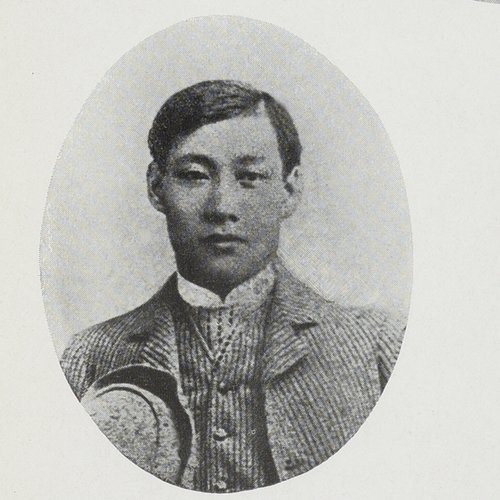
In 1881 the Chinese government dissolved the Educational Mission and ordered the students home. Political changes at home and increased diplomatic tension between China and the United States militated against its continuance. There was also legitimate concern that the Chinese students were losing their cultural identity (LaFargue, 44-51; Rhoads 160-162); even that many had compromised their facility to read and write in their native language (Rhoads, 158). Whether specific membership in the Chinese Christian Home Mission was as important a factor as Joseph Sawyer would later claim is open to question (Sawyer, Chinese, [7-8]), but the overall influence of Christianity on the students certainly impacted the decision. From the students’ point of view, the timing was terrible. Many were in the early stages of their college careers; others were still finishing high school. The lofty goal of obtaining university educations and bringing that expertise back to China was summarily set aside (LaFargue, 52)
Most of the CEM students embarked for China in July 1881. The order to dissolve the program was rescinded almost as soon as they reached home, but it was too late. Virulently anti-Chinese legislation in the United States – the Chinese Exclusion Act of 1882 – prevented their return (Rhoads, 4, 172).
The Students After CEM
Not everyone obeyed the order to return to China. One of two who ignored the recall order was Williston’s Tan Yaoxun, already enrolled at Yale. Possibly with the complicity of Yung Wing, he hid for a time, then reappeared in Easthampton, where he publicly professed his Christian faith at the Payson Church, then returned to Yale, where he graduated in 1883 (Rhoads 162-164). Williston records, largely derived from the June, 1884 Yale Obituary Record, indicate that following graduation, he accepted a post with the Chinese Consulate in New York, but his health failed. He returned to the home of a friend in Connecticut where, in November 1883, he died.
For the histories of the other ten Williston CEM students, we may rely on research by Edward Rhoads (190-194), and on notes derived from a letter written by Kuang Jingyang to Joseph Sawyer in 1916. The existence of this document suggests that Williston’s Chinese contingent stayed in touch with one another. Kuang became a leading railroad construction engineer, who worked on China’s very first rail line and subsequently many other major routes.
Chen Ronggui was initially assigned to a coal mining concern, but became an interpreter to the Director of the Imperial Railways, and eventually returned to the United States as a translator for the Chinese Legation in Washington, D.C. Fang Boliang was employed in the Telegraph Service, then worked with the railways. He taught in a government telegraphy school in Guangdong, and may have become a Christian missionary there. After an assignment to the Tianjin Naval Academy, Wang Fengjie became an interpreter at the Chinese embassy in London, where he died in 1895. Zhang Xianghe went on to an active diplomatic career, serving with the Chinese legations in Lima, Madrid, and Washington, D.C. In 1903 he became an interpreter at the U.S. Consulate in Tianjin. He died there in 1912.
Kuang Jingyang reported that Cheng Daqi, who had returned to China in 1877, died in Shanghai in 1900. Rhoads (196) places him at the Shanghai Naval Arsenal. Liu Jiazhao was in government civil service in Mukden, Manchuria, but eventually returned to Guangdong, where he died in 1915. Kuang Yonzhong and Yang Zhaonan worked in the Fuzhou Navy Yard; they were killed when the French destroyed the Chinese fleet there in 1884. And last, Kuang Xianzhou died in an 1890 coal mining accident in Tangshan.
After 1881 Williston’s international population would continue to grow and diversify. Significant numbers of students arrived from several Latin American countries, as did the first of many from Thailand and Korea. But no more Chinese would attend Williston until 1907. That changed suddenly in 1909-10, when fully ten percent of the senior class was from China. Their story, and that of those who came afterwards, will appear in a future post.
For a sequel to this article, please see Early Chinese Students at Williston: Part II.
Works Cited
LaFargue, Thomas E. China’s First Hundred: Educational Mission Students in the United States, 1872-1881. Pullman: State College of Washington, 1942. Reprinted, with a new introduction, Pullman: Washington State University Press, 1987.
Metraux, Daniel A. “How Bret Harte’s Satirical Poem “The Heathen Chinee” Helped Inflame Racism in 1870s America.” Southeast Review of Asian Studies 33, 2011. (https://www.questia.com/library/journal/1G1-293544471/how-bret-harte-s-satirical-poem-the-heathen-chinee)
Rhoads, Edward J. M. Stepping Forth Into the World: The Chinese Educational Mission to the United States, 1872-81. Hong Kong: Hong Kong University Press, 2011.
Sawyer, Joseph Henry. “The Chinese Christian Home Mission.” The Independent, July 5, 1894, p. 13 f. Reprint, Williston Seminary, 1917.
Sawyer, Joseph Henry. A History of Williston Seminary. Easthampton, Mass.: The Trustees, 1917.
Sizer, Nancy Faust. China: a Brief History. Wellesley Hills, Mass.: Independent School Press, 1979.


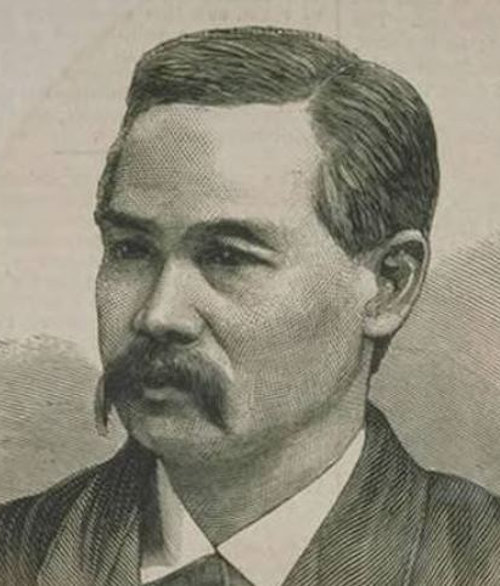
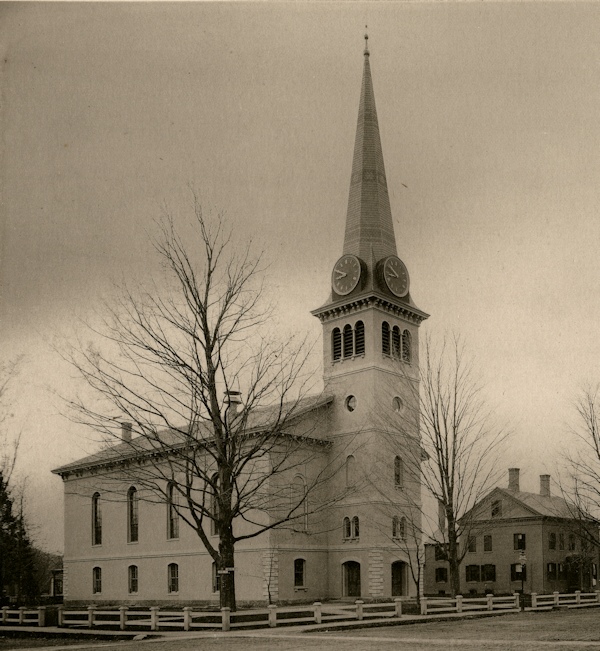
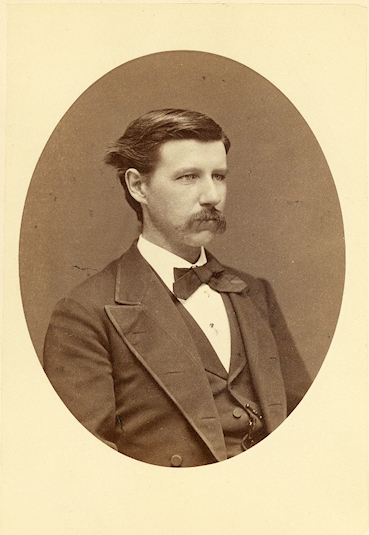
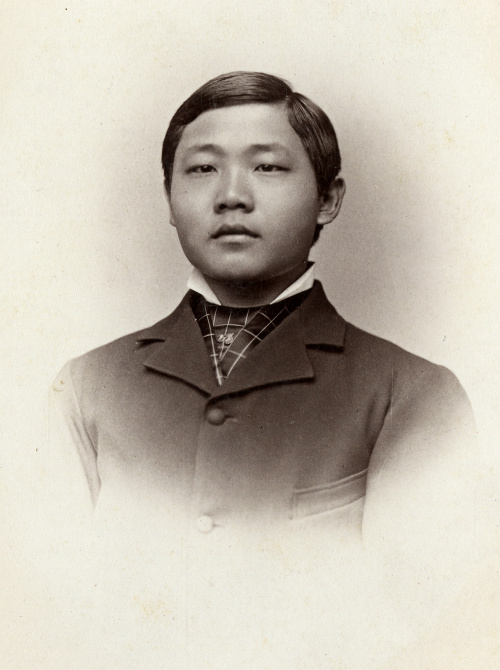
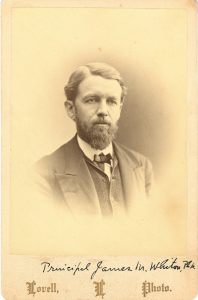

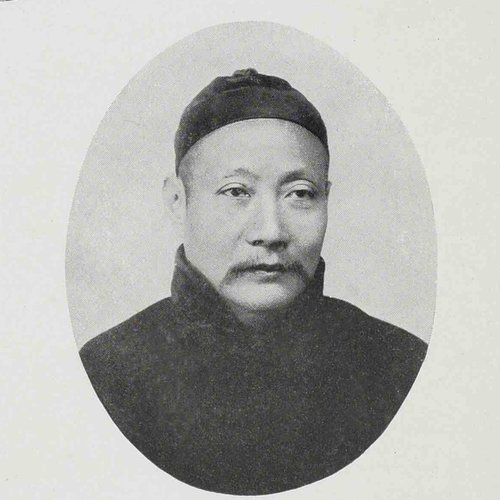
Given my recent ten year stay in China and my keen interest in Chinese culture and language, I really enjoyed reading Rick’s article. Having also taught in Chinese schools, I can vouch for the fact that most Chinese are well disciplined and attentive learners.